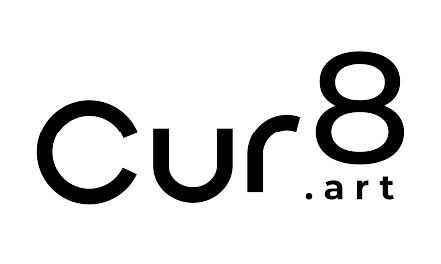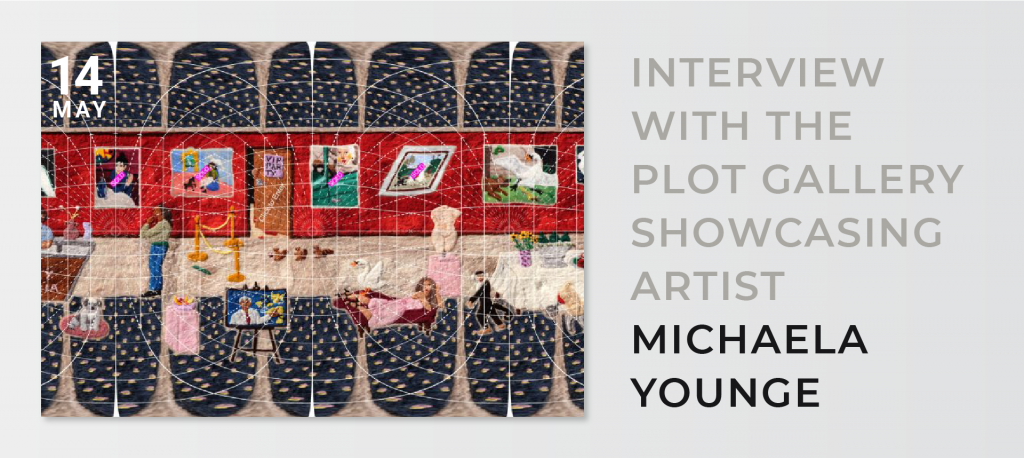

How would you define The Plot Gallery?
The Plot Gallery: We exist as a disruptive online gallery environment. We are interested in exploring new and innovative art formats that question and contribute to the ways in which we create, receive, and exhibit cultural content going forward. Although we have no plans to exist as a bricks and mortar gallery we are constantly exploring unique ways that link the virtual spaces we create and the physical artworks that we exhibit.
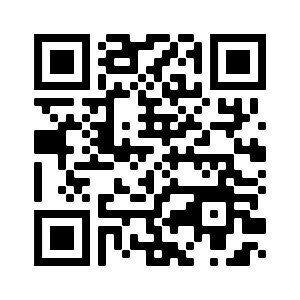

How was this idea of a virtual gallery conceptualised?
The Plot Gallery: There were many questions that we were interested in answering, namely ‘what is a more dynamic way of experiencing art online?’ Instead of simply mimicking what is real, we wanted to build unique virtual experiences to complement our physical world (not replace it). This led us to explore the idea of ‘online art atmospheres’ that exist as immersive virtual worlds that present art outcomes in a very unique way. We were very much interested in answering these questions pre-pandemic and then with lockdown in South Africa, it brought these questions to the immediate foreground.
How has the idea evolved over time?
The Plot Gallery: The idea has evolved a lot from the initial departure point, namely due to the collaborative way in which we want to work with artists. Naturally there needs to be room enough for things to change and evolve to what is suited to someone’s art practice, to the materials that they work with, or even to their own ambitions as artists.
Can you tell us more about The Plot Gallery’s initial projects?
The Plot Gallery: The first projects were very experimental – they existed solely as unique online enquiries and weren’t monetized in any way. These pilot studies were rooted in the ambition to introduce a spatial quality to the ways in which we all ‘gather’ online.


The Plot Gallery’s initial spatial environment called ‘Inside <> Out’, March 2020
The first project titled Inside <>Out used public participation to explore the shifting narratives we saw emerging in our domestic interiors during lockdown. We created a virtual base camp for the exhibition and through an open call, used publicly submitted moments to populate an evolving scene of people’s intimate domestic world.
The success of the Inside <> Out exhibition led us to think more about the untapped spatial potential of the Internet. As a next step we wanted to use video content to activate a virtual space in a seemingly live (real) way. We wanted to question the materiality of the online and create more immersive experiences for people to explore. For this second exhibition we worked with various artists to create bespoke video content that we rendered into a virtual interior scene that we called The Electric Blue Bedroom.
How were the online ‘art experiences’ created by The Plot Gallery received by the public?
The Plot Gallery: It has been received very well by the local South African art world. Soon after we started we were welcomed by FNB Art Joburg 2020 to present our first solo show featuring Cape Town based artist Michaela Younge. It was interesting to work with one artist to fully explore the new exhibition formats that we had been prototyping – for technical reasons, featured artists have to work within certain parameters in order for us to create coherent online spatial environments with them.
Can you tell us more about this virtual exhibition at FNB Art Joburg in 2020?


Michaela Younge, The Gallery Galleria, 2020, Merino wool on felt
The Plot Gallery: This was our first solo exhibition showcasing works by Michaela Younge – the show was the first time we used 360 image making as a tool to transform an artist’s work into unique spatial atmospheres. Through this process, an art palimpsest emerged where the online exhibition formats became the artworks and visa-versa. Navigating this slippery territory between representation and the real is what interests us a lot and this is partly why we think The Plot Gallery is so exciting.


Michaela Younge, The Gallery Galleria, 2020, Merino wool on felt
The above image shows the ‘equirectangular’ image (another 360 image format) that we created with Michaela. The artist has to be aware of what will distort with the creation of these spatial environments in order to achieve the desired art outcome (physically and virtually). The collaborative workflow required to do what we do is a break from the traditional gallery/ artist relationship. Our hope is that this will help breaking down existing biases around how to present, receive, and produce cultural content going forward.
Can you tell us about your recent exhibition with Michaela Younge showcasing her body of work Caught red-handed in the VIP Room?


View the above QR code for an immersive virtual experience of Michaela Younge’s Caught red-handed in the VIP Room, 2020
The Plot Gallery: Michaela Younge created six tailor-made felt scenes titled Caught red-handed in the VIP Room for our latest online art exhibition. The online worlds we have been creating are governed by specific technical requirements. Making sure the artist is aware of these and understands how to work within and/ or manipulate these ‘rules’ is an important part of the process. If we look at the previous exhibition, Michaela Younge had to work with a specific process and within a certain format so that the featured artworks would translate seamlessly into a 360 viewing experience.


Michaela Younge, Caught red-handed in the VIP Room, 2020, Merino wool on felt 
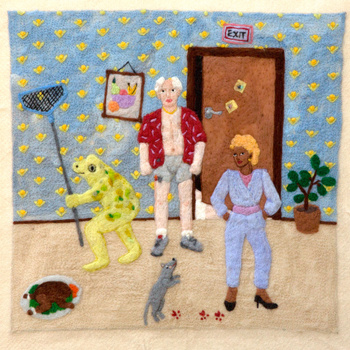
Michaela Younge, Caught red-handed in the VIP Room, 2020, Merino wool on felt
For the body of work with Michaela, different 360 image formats were used. As an example, we can see in the below image how six artworks fold together to create one complete art scene. This format is called ‘cube map’. It is exciting how this process of 360 image-making can inform a new approach, process, and outcome for the artists we work with. We have had a lot of fun exploring the different ways this has helped bridge our online and physical worlds.


Michaela Younge, Caught red-handed in the VIP Room, 2020, Merino wool on felt
What ambitions does The Plot Gallery have going forward?
The Plot Gallery: We already have a few exciting local collaborations and exhibitions in the pipeline but seeing that we are not limited by a physical location – we aim to broaden our scope and reach a global scale. Continuing to work with interesting artists and institutions to create more new and unique art experiences will allow The Plot Gallery to grow over time.
Follow @the_plot_gallery to stay up to date on our news or sign up to our art mailer via our website online www.theplotgallery.com
Can you tell us a little more about your current show with The Plot Gallery? What inspired this body of work titled Caught red-handed in the VIP Room?

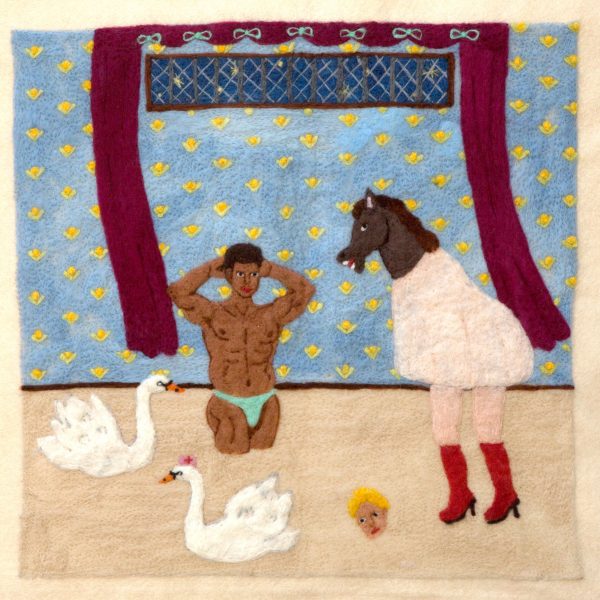
Michaela Younge, Caught red-handed in the VIP Room, 2020, Merino wool on felt 
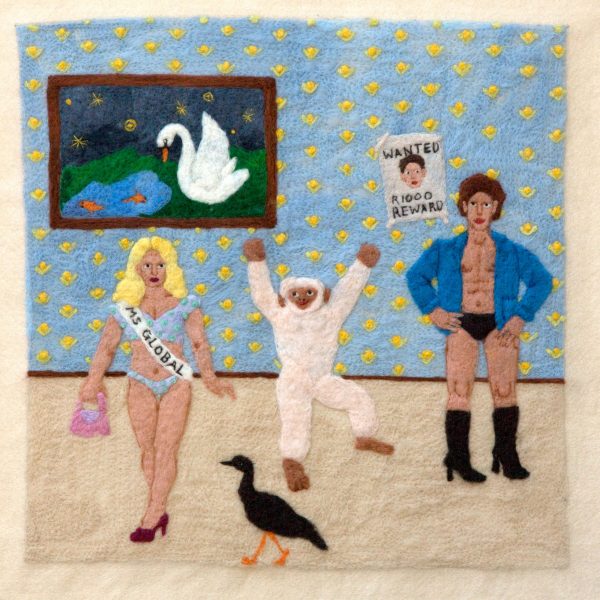
Michaela Younge, Caught red-handed in the VIP Room, 2020, Merino wool on felt
Michaela Younge: Before the project, the only experience I had had with augmented environments was through games and filters. We started the project in collaboration with the fair FNB Art Joburg, which had been moved online during the pandemic and the worldwide lockdowns. Part of the fair was to be experienced through an Instagram filter that played into our main environment that was hosted by The Plot Gallery. We decided to create a space that made a nod to the nostalgic game of Cluedo, with a ‘whodunnit’ aspect and the mystery of who killed the fictional character ‘Pieter Deon’.

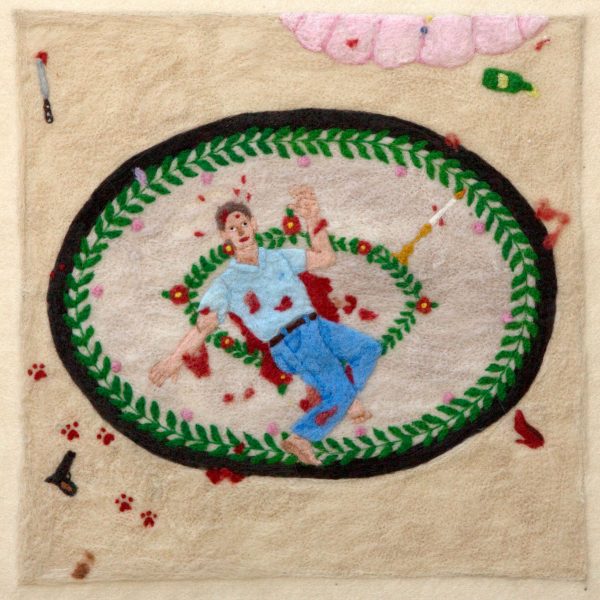
Michaela Younge, Caught red-handed in the VIP Room, 2020, Merino wool on felt 
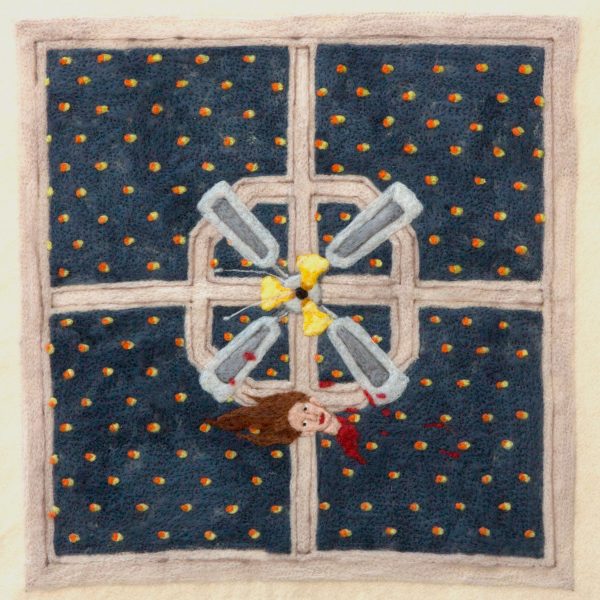
Michaela Younge, Caught red-handed in the VIP Room, 2020, Merino wool on felt
When you first enter the space, you are in the gallery room, that you can pan across and zoom into the artworks on the wall that are made up of miniature recreations of well-known works that one can buy in real life and on their own. From the gallery room, one can click on the door of the VIP room, where you enter a party of sorts. When you pan down, the body of ‘Pieter Deon’ is below you, as if you’re standing over him. The idea was that once you entered the VIP room you would experience the world with a magnifying glass in hand, naming you as detective and you could ‘solve’ who may have murdered this man. Around the body are various objects that may have been used as the weapon – a candlestick, a red high heel, a knife, a bottle and so on.
From the beginning of the project I knew that I wanted to create a ‘false’ gallery, where miniature artworks could be sold from, as real life galleries were closed due to worldwide lockdowns. I was playing with the idea of whether or not the gallery space is part of the experience of the artwork. The VIP space is currently on show at the Open Co in Cape Town.
